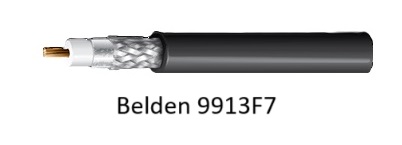No products in the cart.
RG8 coaxial cables have been widely used in telecommunications and networking applications due to their ability to transmit radio frequency (RF) signals over long distances with minimal signal loss. However, let’s delve into the details:
-
RG-8/U:
- Structure: RG-8/U is a 50-ohm double-shielded coaxial cable with an outer diameter of 0.405 inches. It features:
- An inner 7-stranded bare copper conductor.
- Insulation typically made of low-density solid Polyethylene (PE).
- A shield layer made of bare copper braid or a combination of bonded aluminum foil & bare copper braid.
- An outermost jacket made of Polyvinyl Chloride (PVC).
- Specifications:
- Characteristic Impedance (Zo): 50 ohms (±2).
- Maximum Operating Voltage (Vrms): 4000.
- Cable Capacitance (pF/ft): 23.7 – 29.6.
- Attenuation (dB/100 ft, @ 400 MHz):
- Applications: RG-8/U is ideal for point-to-point & point-to-multipoint wireless antenna communication, amateur (Ham) radio, GPS, RFID, and various residential & commercial uses.
- Structure: RG-8/U is a 50-ohm double-shielded coaxial cable with an outer diameter of 0.405 inches. It features:
-
RG-8X/U:
- Structure: RG-8X/U is a 50-ohm coaxial cable with an outer diameter of 0.242 inches. Its features include:
- An inner stranded bare copper conductor with 19 x 29 stranding.
- Insulation typically made of Form Polyethylene (PE).
- A shield layer made of bare copper braid or a combination of aluminum foil & Tinned braid.
- An outermost jacket made of PVC.
- Maximum Working Voltage (Vrms): Up to 2500
- Structure: RG-8X/U is a 50-ohm coaxial cable with an outer diameter of 0.242 inches. Its features include:
| Cable Type | Characteristic Impedance (Zo) | Outer Diameter | Inner Conductor | Shielding | Applications |
|---|---|---|---|---|---|
| RG-8/U | 50 ohms (±2) | 0.405 inches | 7-stranded bare copper | Double-shielded (copper braid + aluminum foil) | Point-to-point & point-to-multipoint wireless communication, amateur radio, GPS, RFID, residential & commercial use |
| RG-8X/U | 50 ohms | 0.242 inches | Stranded bare copper (19 x 29) | Single-shielded (copper braid + aluminum foil) | General-purpose applications, shorter cable runs |
RG-8 Cable in Dubai, RG8 Cable in Dubai, RG-8 Cable Shop in Dubai, RG8 Coaxial Cable Supplier, RG-8 Coaxial Cable Supplier, RG-8 Cable Supplier, RG8 Cable Supplier, RG-8 Coaxial Cable Price, RG-8 Cable Price, RG8 Cable Price, RG8 Coaxial Cable For Sale, RG-8 Coaxial Cable For Sale, RG-8 Cable For Sale, RG8 Cable For Sale.



 العربية
العربية Français
Français Português
Português گؤنئی آذربایجان
گؤنئی آذربایجان Türkçe
Türkçe Lietuviškai
Lietuviškai Español
Español

